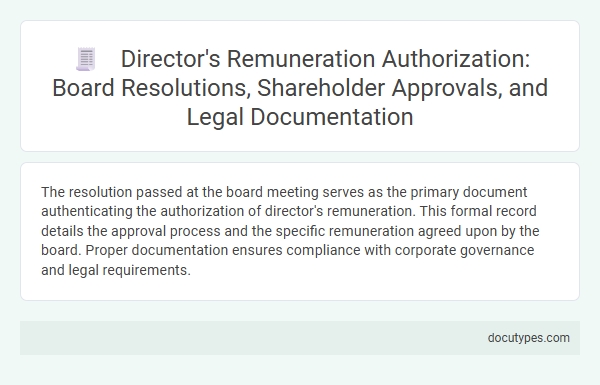The resolution passed at the board meeting serves as the primary document authenticating the authorization of director's remuneration. This formal record details the approval process and the specific remuneration agreed upon by the board. Proper documentation ensures compliance with corporate governance and legal requirements.
Overview of Director’s Remuneration in Corporate Governance
Which document authenticates the authorization of director's remuneration in corporate governance? This authorization is typically verified through the company's board resolution or shareholders' meeting minutes. These documents provide formal approval and ensure compliance with corporate governance standards.
Legal Framework Governing Director’s Remuneration
The legal framework governing director's remuneration is primarily established through corporate governance codes and statutory regulations. The key document authenticating the authorization of director's remuneration is the board resolution approved by the company's board of directors.
- Board Resolution - This formal document records the board's decision to approve director's remuneration as per company bylaws and legal requirements.
- Articles of Association - These outline the procedures and limits on remuneration approval within the company, serving as a foundational legal reference.
- Shareholders' Approval - In many jurisdictions, director remuneration must be ratified by shareholders during the annual general meeting to ensure transparency and compliance.
Board Resolution Process for Approving Director’s Remuneration
The key document that authenticates the authorization of a director's remuneration is the board resolution. This resolution is passed during a formal board meeting where the amount and terms of the director's remuneration are discussed and approved.
Board resolutions serve as legal proof that the remuneration has been duly authorized by the company's directors. Your approval process should include documenting the specifics of the remuneration and ensuring compliance with relevant corporate governance regulations.
Drafting Effective Board Resolutions on Director Payment
The document that authenticates the authorization of director's remuneration is the Board Resolution. Drafting effective board resolutions on director payment requires clear articulation of the remuneration amount, basis of calculation, and approval details. Including specific clauses related to compliance with the Companies Act and shareholder approvals strengthens the validity of the remuneration authorization.
Shareholder Approval: Requirements and Procedures
The document that authenticates the authorization of director's remuneration is the board resolution approved by the shareholders. Shareholder approval requires a formal meeting or a written resolution where the remuneration details are disclosed and consented. Proper documentation, including minutes of the meeting or signed resolution forms, serves as legal proof of authorization.
Legal Documentation Required for Remuneration Authorization
The authorization of a director's remuneration is primarily authenticated through the company's board resolution. This legal document serves as formal approval and outlines the specific remuneration terms agreed upon by the board.
Board resolutions must comply with corporate governance principles and be documented in the minutes of the meeting. Shareholder approval may also be required, depending on jurisdiction and company bylaws. Supporting documents such as employment contracts and remuneration policies provide additional legal backing for the authorized payment.
Compliance with Statutory Limits and Regulatory Guidelines
The document that authenticates the authorization of director's remuneration is the Board resolution or shareholders' approval minutes. These documents serve as legal proof that the remuneration complies with statutory limits and regulatory guidelines set forth by corporate law.
Compliance with the Companies Act and Securities Exchange regulations ensures that director remuneration does not exceed prescribed thresholds. Regulatory authorities require these documents to validate that compensation aligns with governance standards and transparency requirements.
Disclosure and Reporting Obligations for Director Remuneration
The document that authenticates the authorization of a director's remuneration is typically the company's board resolution or the shareholders' meeting minutes. These records ensure legal compliance and transparency in director compensation.
Disclosure and reporting obligations require companies to accurately present director remuneration details in financial statements and regulatory filings, safeguarding stakeholder interests.
- Board Resolution - Official approval by the board of directors formalizes the authorization of director remuneration.
- Shareholders' Meeting Minutes - Documentation of shareholder consent validates the remuneration policy and any related changes.
- Annual Financial Statements - These public documents disclose total director remuneration, fulfilling regulatory transparency requirements.
Common Pitfalls and Legal Risks in Remuneration Authorization
The primary document authenticating the authorization of a director's remuneration is the board resolution or shareholder resolution, depending on the company's governance structure. Proper documentation ensures compliance with corporate laws and prevents disputes over remuneration legitimacy.
- Board Resolution - This resolution formally approves director remuneration in accordance with company bylaws and legal requirements.
- Shareholder Resolution - Certain jurisdictions mandate shareholder approval for director pay, making this document crucial for authorization.
- Employment Contract - It outlines agreed remuneration terms, but requires formal board or shareholder approval to be legally valid.
Failure to secure and document proper authorization exposes companies to legal risks, including challenges to director remuneration and regulatory penalties.
Which Document Authenticates the Authorization of Director’s Remuneration? Infographic

